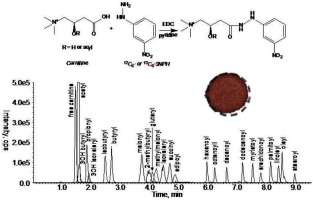当前位置:
X-MOL 学术
›
Anal. Chim. Acta
›
论文详情
Our official English website, www.x-mol.net, welcomes your
feedback! (Note: you will need to create a separate account there.)
Isotope-labeling derivatization with 3-nitrophenlhydrazine for LC/multiple-reaction monitoring-mass-spectrometry-based quantitation of carnitines in dried blood spots
Analytica Chimica Acta ( IF 5.7 ) Pub Date : 2018-12-01 , DOI: 10.1016/j.aca.2018.01.045 Jun Han , Rehan Higgins , Mark D. Lim , Kieran Atkinson , Juncong Yang , Karen Lin , Christoph H. Borchers
Analytica Chimica Acta ( IF 5.7 ) Pub Date : 2018-12-01 , DOI: 10.1016/j.aca.2018.01.045 Jun Han , Rehan Higgins , Mark D. Lim , Kieran Atkinson , Juncong Yang , Karen Lin , Christoph H. Borchers

|
Carnitines are diagnostic biomarkers of fatty acid oxidation defects and organic acidemias. Quantitative measurements of various carnitines in dried blood spot (DBS) have potential use in remote health applications for disease diagnosis and epidemiological surveillance. To provide an improved LC/multiple-reaction monitoring (MRM)-MS method for quantitation of carnitines in DBS, 3-nitrophenylhydrazine (3NPH) was tested as a high-efficiency chemical isotope-labeling reagent for pre-analytical derivatization of 24 routinely-analyzed species. Reaction conditions were optimized and carnitine structural isomers were separated by reversed-phase LC with positive-ion MRM/MS detection, giving on-column lower LOQs of sub- to low-femtomole levels. 13C6-3NPH was used to produce 13C6- or 13C12-labeled derivatives of the mono- and di-carboxylic carnitines in a "one-pot" reaction. These labeled analogues were used as stable isotope-labeled internal standards to compensate for possible ESI matrix effects. Combined with an optimized, two-step procedure for the extraction of carnitines from DBS, this isotope-labeling derivatizaiton - LC/MRM-MS method provided good linearity, high precision (intra-day CVs of ≤7.8% and inter-day CVs of ≤8.8%) and high accuracy (three levels of standard substances spiked in, with recoveries of 86.9%-109.7%) quantitation of carnitines in three sets of DBSs on cellulose or cotton filter paper. This method was then applied to determine the concentration changes of the analytes in the DBSs under two stability-testing regimes: 1) a one-time 4-h sunlight exposure and 2) a set of cycled temperature transitions (-20 °C for 2 days, 40 °C for 2 days, and back to -20 °C for 2 additional days). All of the carnitines showed good stabilities under the first testing condition. Under the second testing condition, free carnitine showed concentration increases of 9.3%-16.1%; acetyl carnitine, 3-OH butyryl carnitine, and malonyl carnitine showed concentration decreases of 12.2%-17.3%, 12.9%-17.1% and 10.7%-15.3%, respectively, and other 20 acyl carnitines showed concentration changes of <10% in three sets of DBSs on cellulose or cotton filter paper. These preliminary stability-testing results indicate a need to more systematically investigate the effects of various environmental conditions on the chemical stabilities of carnitines in DBS specimens if this sampling method is to be used in remote health applications.
中文翻译:

用 3-硝基苯肼进行同位素标记衍生化,用于干血斑中肉碱的 LC/多反应监测-质谱法定量
肉碱是脂肪酸氧化缺陷和有机酸血症的诊断生物标志物。干血斑 (DBS) 中各种肉碱的定量测量在远程健康应用中具有潜在用途,可用于疾病诊断和流行病学监测。为了提供一种改进的 LC/多反应监测 (MRM)-MS 方法来定量 DBS 中的肉碱,我们测试了 3-硝基苯肼 (3NPH) 作为高效化学同位素标记试剂,用于 24 种常规分析前衍生化 -分析的物种。反应条件得到优化,肉碱结构异构体通过反相 LC 与正离子 MRM/MS 检测进行分离,从而提供亚至低飞摩尔水平的柱上低 LOQ。13C6-3NPH 用于在“一锅”反应中生产单和二羧酸肉碱的 13C6 或 13C12 标记的衍生物。这些标记的类似物用作稳定同位素标记的内标,以补偿可能的 ESI 基质效应。结合从 DBS 中提取肉碱的优化的两步程序,这种同位素标记衍生化 - LC/MRM-MS 方法提供了良好的线性、高精度(≤7.8% 的日内 CV 和 ≤7.8% 的日间 CV ≤8.8%)和高准确度(掺入三个水平的标准物质,回收率为86.9%-109.7%)在纤维素或棉滤纸上对三组DBS中的肉碱进行定量。然后应用该方法来确定 DBS 中分析物在两种稳定性测试方案下的浓度变化:1) 一次 4 小时的阳光照射和 2) 一组循环温度转换(-20 °C 2 天,40 °C 2 天,然后回到 -20 °C 2 天)。所有肉碱在第一次测试条件下都表现出良好的稳定性。在第二个测试条件下,游离肉碱的浓度增加了9.3%-16.1%;乙酰肉碱、3-OH丁酰肉碱和丙二酰肉碱浓度分别下降12.2%-17.3%、12.9%-17.1%和10.7%-15.3%,其他20种酰基肉碱浓度变化<10%。纤维素或棉滤纸上的 DBS 组。
更新日期:2018-12-01
中文翻译:

用 3-硝基苯肼进行同位素标记衍生化,用于干血斑中肉碱的 LC/多反应监测-质谱法定量
肉碱是脂肪酸氧化缺陷和有机酸血症的诊断生物标志物。干血斑 (DBS) 中各种肉碱的定量测量在远程健康应用中具有潜在用途,可用于疾病诊断和流行病学监测。为了提供一种改进的 LC/多反应监测 (MRM)-MS 方法来定量 DBS 中的肉碱,我们测试了 3-硝基苯肼 (3NPH) 作为高效化学同位素标记试剂,用于 24 种常规分析前衍生化 -分析的物种。反应条件得到优化,肉碱结构异构体通过反相 LC 与正离子 MRM/MS 检测进行分离,从而提供亚至低飞摩尔水平的柱上低 LOQ。13C6-3NPH 用于在“一锅”反应中生产单和二羧酸肉碱的 13C6 或 13C12 标记的衍生物。这些标记的类似物用作稳定同位素标记的内标,以补偿可能的 ESI 基质效应。结合从 DBS 中提取肉碱的优化的两步程序,这种同位素标记衍生化 - LC/MRM-MS 方法提供了良好的线性、高精度(≤7.8% 的日内 CV 和 ≤7.8% 的日间 CV ≤8.8%)和高准确度(掺入三个水平的标准物质,回收率为86.9%-109.7%)在纤维素或棉滤纸上对三组DBS中的肉碱进行定量。然后应用该方法来确定 DBS 中分析物在两种稳定性测试方案下的浓度变化:1) 一次 4 小时的阳光照射和 2) 一组循环温度转换(-20 °C 2 天,40 °C 2 天,然后回到 -20 °C 2 天)。所有肉碱在第一次测试条件下都表现出良好的稳定性。在第二个测试条件下,游离肉碱的浓度增加了9.3%-16.1%;乙酰肉碱、3-OH丁酰肉碱和丙二酰肉碱浓度分别下降12.2%-17.3%、12.9%-17.1%和10.7%-15.3%,其他20种酰基肉碱浓度变化<10%。纤维素或棉滤纸上的 DBS 组。


















































 京公网安备 11010802027423号
京公网安备 11010802027423号